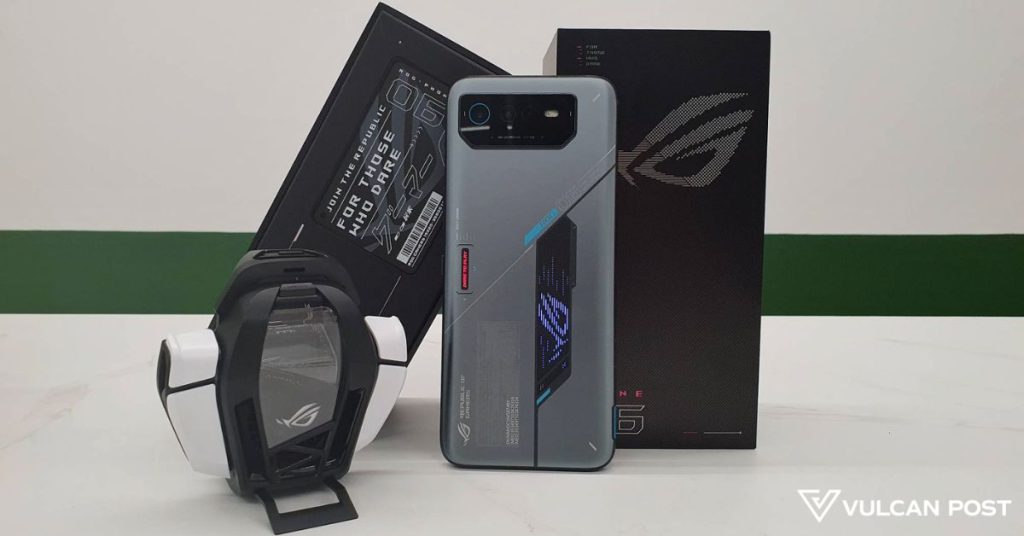The ASUS ROG Phone 6 already impressed me in an earlier review, and though I didn’t play with the ASUS ROG Phone 6 Batman Edition for long, what little time I had with it was still a good time.
As expected, the ROG Phone 6D lived up to the same standards, and on the surface, it really doesn’t appear all that different from the Phone 6.
It’s got the same polished back, giving it a slightly rugged look with intercepting lines and statements in blocky fonts.
Then, of course, there’s the signature illuminated RGB matrix display on the back which can be customised to fit your mood or to reflect notifications/activity on your phone.
The camera housing is the same as well, neatly kept out of the way for comfortable landscape gaming.
The ROG Phone 6D only comes in one colourway, Space Gray.

Below the surface is where this phone begins differing from the ROG Phone 6, as instead of a Snapdragon chipset, it has a MediaTek Dimensity 9000+ 5G chipset.
The two chipmakers are often pitched against one another, with Snapdragon usually said to be better in several aspects.
However, from my experience of using the ROG Phone 6 and ROG Phone 6D for the same purposes, I felt very little difference. More on that later though.
Like the other phones in the ROG Phone 6 series, the ROG Phone 6D has a 6.78-inch, AMOLED HDR10+ display with a 165Hz refresh rate.
The Armoury Crate app functions the same way too, allowing users to adjust their settings for an optimal gaming experience. Swap between X-Mode to boost performance, Dynamic for a balance user experience, or Ultra durable (Eco) to conserve battery life.

This is also where one would control the AirTriggers, mapping up to 14 customisable touch points on the screen simultaneously.
Coming with the ROG Phone 6D review unit we got was also the AeroActive Cooler 6 for testing, though it doesn’t actually come bundled with this model, only the ROG Phone 6D Ultimate.

The built-in GameCool 6 cooling system is able to keep the phone’s temperature down for daily use, but as you game in X-Mode, you’ll begin to feel some heat build-up, which the AeroActive Cooler 6 is meant to combat.
We’ve not tried its predecessors, but from pictures alone, the newest version of the peripheral looks more modern and edgier. It’s a sleek design that matches with the ROG Phone 6 series itself, to no surprise.
The clip-on accessory uses a spring-loaded latching mechanism, allowing the AeroActive Cooler 6 to hug the phone snugly.
It draws power directly from the phone through a USB-C attached to the side-mounted charging port, meaning that there are no finicky wires to get in the way of your gaming.
If your phone begins running out of juice though, the cooler itself has a USB-C port that you can plug a charging wire into, so you can simultaneously charge your phone as it cools.
The AeroActive Cooler 6 has a kickstand for your phone to stand somewhat upright horizontally, and four additional physical buttons for game input.

This brings the aforementioned 14 simultaneous touchpoints to a total of 18 when the AeroActive Cooler 6 is attached.
The four buttons on the cooler are omnidirectional, which means they can be pressed from any direction and in any spot. I found myself using these a lot more than the AirTrigger spots on the phone’s edge since they were more effortless and natural to press.
Controls for the cooler are accessed through the Armoury Crate too, with the option to supplement the fan with thermoelectric cooling through the use of a Peltier cooler.
With the cooling mode turned on, you can switch between Smart, Cool, Frosty, and Frozen (only available when the charging cable is plugged into the AeroActive Cooler 6.

Frosty was able to keep the phone pretty cool to the touch when I played Genshin Impact on overclocked settings for about an hour.
That being said though, even without the cooler attached, I was still able to game in X-Mode rather comfortably without stutters or lag.
When the cooler is connected to the phone, X-Mode also changes to X-Mode+, boosting the phone’s performance.

Coming back to the ROG Phone 6D itself, it gives the user no space to harbour doubts about its gaming capabilities and performance.
With a large 6.000mAh battery and 65W wired charging, running out of juice on this phone shouldn’t really be a concern, unless you’re gaming on X-Mode for half a day straight, probably.
For a gaming phone, its cameras are decently impressive too, meeting flagship daily driver standards easily.
It has a 50MP wide camera, 13MP ultrawide, and 5MP macro on the back, with a 12MP selfie camera.
These are found on the ROG Phone 6 too, which we often use as a backup phone for pictures and videos in our content creation.
Verdict
Besides the chipset, the ROG Phone 6D really doesn’t differ from the ROG Phone 6. Benchmarks would probably show some differences, but I doubt that my daily usage and gaming tendencies would ever push the phones to such limits anyway.
As for which phone is better than the other, it would likely come down to your own chipset preferences or what you plan to do with the phone.
The ASUS ROG Phone 6D only comes in a 12GB 256GB variant and costs RM3,499, RM100 cheaper than the ROG Phone 6.
| Pros | Cons |
|---|---|
| Excellent battery lasting power, with super fast charging speeds | No wireless charging |
| Great 165Hz display for lag-free and responsive gameplay | |
| Decent cameras, comparable to a flagship’s |
VP Verdict is a series where we personally try and test out products, services, fads, and apps. Want to suggest something else for us to try? Leave a comment here or send the suggestion to our Facebook page.











